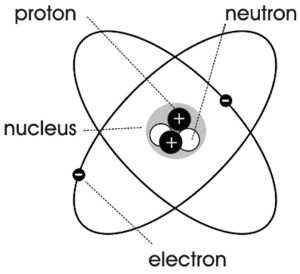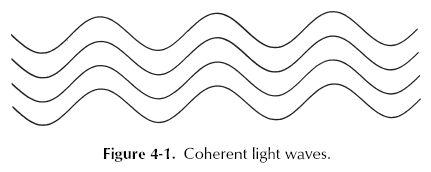I'll just say it: There aren't many science fiction stories out there that don't involve lasers in some way.
Lasers are a popular way of showing that society evolved past the use of barbaric projectile weapons to a more space-age, hi-tech means of putting holes in other people. It seems like a natural progression, doesn't it? So, with that in mind, let's investigate what lasers are, how they work, how they're being used, and how you can accurately use them in your own work.
A primer on light waves
Lasers beams are simply a form of light, so we probably need to cover how light works.
First, the smarties among you already know that the material of light is pretty interesting. Light exhibits behavior like particles (known as photons) at the same time as exhibiting the behavior of waves. This is known as light wave-particle duality, and while it's interesting, it's a little beyond the scope of this article. We're not going to look too closely at the particulate nature of light, but we do need to understand light's wave properties to understand lasers.
Human eyes are sensitive to a relatively narrow range of electromagnetic radiation we've appropriately termed "visible light." Visible light wavelengths range from about 400 to 700 nanometers. Outside of the visible spectrum, we have radio waves and x-rays, which are part of the same electromagnetic spectrum, but invisible to humans. Bees, on the other hand, can see in the ultraviolet range, which helps them to locate nectar in flowers.
So where do photons come from? It's time to reach back into our grade-school science days and remember those little subatomic particles known as electrons. Electrons are the little things you were probably taught orbit the nucleus of an atom (not exactly, but close enough), and are assigned to certain levels (orbital shells) depending on how big the atom was (again, not exactly, but close enough).
Electrons can move up in level to a higher orbital shell with the addition of energy. However, when an electron drops down to a lower orbital level, that indicates a decrease in energy. Since energy is never (technically) destroyed, it's got to go somewhere. Sometimes, that energy will leak away in the form of light energy by shooting off photons, such as we see in the filament of a light bulb.
What are lasers?
The word "laser" stands for "Light Amplified by Stimulated Emission of Radiation," which is a fact that will get you all of the dates, by the way. I could explain exactly what that means, but it's easier if we think in pictures.
First, imagine you have in front of you an entire orchestra. Violins, trumpets, percussion, and that weird fellow with the didgeridoo, they're all here, waiting for your signal. You tap the podium, gently give the signal, and like a typhoon of angry, sick elephants, every member of the band begins playing at once, blowing you off your feet and into the third aisle.
That's sort of what a regular light bulb is doing. The electrons are excited by the addition of power running through the filament, and move up a level to the next orbital shell. Then they fall back down, releasing a photon in some random direction at some random time at some random wavelength.
Now, instead imagine that you are a competent conductor with a competent orchestra. As you wave your magic conductor wand (whatever that thing is called), the horns come in softly, all at the same time, all in the same tune, producing the beautiful opening note to your composition.
That's what a laser is doing. Unlike a regular light bulb, the photons coming out of a laser have some similar qualities:
1) Laser photon waves are spatially coherent, which means that they are spaced evenly from one another, which is what causes them to exit from the device in a tight, directional beam rather than as a flood like a flashlight.
2) Laser photon waves are temporally coherent, which means that the waves line up precisely with one another. Remember that wavelength determines color in visible light, so all laser light is going to be almost exactly the same color in order to achieve temporal coherence.
Now, laser light is still just light. But the result of producing light with a laser is a focused, intense, directional beam rather than the soft light produced naturally. Also, since everything is literally on the same wavelength, and wavelength defines color in visible light, laser beams will be monochromatic (having one color).
Practical weaponization of lasers
Before we get into the more distant topic of laser guns, let's see how lasers are actually being used today in combat.
Weapon sights
Laser sights are popular additions to firearms when you need to show that your character is a highly organized badass. So how does it work?
Anticlimactically, it's basically a laser pointer. The laser is attached to the gun (usually to the bottom or side) and aligned with the barrel. Because the laser light will travel in a straight line, it will show where the barrel is pointed at all but the most extreme distances. This helps a shooter identify where the bullet should land, which makes it easier to fire quickly and accurately.
Because light can be "lasered" even outside the visible spectrum, some higher-end laser sights are actually configured in the infrared range. This means that the laser dot will be invisible to anyone who isn't looking through a night vision scope or wearing infrared goggles, and significantly increases the cool factor of your black ops ninja assassin.
I should point out that most video games and some movies depict laser sights unrealistically. Instead of just a small dot, the entire beam will be visible, no matter the environmental conditions. Most laser beams can be seen in bad conditions, such as thick dust or heavy rain, but only the more powerful beams will be seen in clear conditions, and these types of lasers are not typically used by professionals for gun sights. It should be obvious that a sniper probably doesn't want a bright "shoot here" sign pointing at him.
Laser guidance
Warfighters have come up with some mighty creative ways of using lasers, and laser guidance is one of the cooler techniques. Using laser guidance, bombs can be dropped onto a designated target with great accuracy. Here's how it works.
First, a target is "painted" by a laser, which is usually either held by a guy on the ground or mounted on an aircraft. The laser light hits the target and scatters, just like any light would upon hitting an opaque object. The light blasts off in every direction and will continue to do so as long as the target is being painted.
Next, a specialized missile or bomb is dropped near the target. The bomb has a sensor which can pick up the laser light as it scatters from the target, and a computer can then calculate where the light is coming from and guide the warhead to the target. Because the laser scatters from a very small area on the painted target, the bomb can hit a target with impressive accuracy.
[video:http://www.youtube.com/watch?v=C8LoRO5UHoQ]
How do you beat something like this? Well, you can use special paint which will absorb the light completely and prevent it from scattering, or you can just throw up a bunch of smoke, which will cause the laser to start scattering from random points in the cloud and make it difficult for the bomb's computer to come up with an origin point.
Non-lethal laser weapons
Surely you remember that you should never point a laser at your eyes, right? Lasers focus a lot of light into a very tiny point, and that point is made even smaller as it passes through the lens of the eye. The photosensitive cells in your retina are not designed to withstand that kind of energy all at once, and can suffer severe burns from the laser beam, which can lead to blindness. While there are laser weapons specifically designed to cause blindness, they are prohibited by the Protocol on Blinding Laser Weapons from the Geneva Convention.
However, a laser weapon that doesn't cause permanent blindness is fair game, and science is already looking into that. One neat example is called "the dazzler," which is a wide-beamed laser weapon of a low-enough power to prevent eye damage, but bright enough to severely disorient criminal drivers.
[video:http://www.youtube.com/watch?v=TcOZvKRpy4Y]
I should also take a moment to address laser pointers and aircraft. For some reason, certain individuals get the giggles by pointing lasers at overhead aircraft, thinking that it ain't no thang. But it is a thang. It's a very bad thang.
You see, when I said that lasers are tight, focused beams, that's true for a pretty good length of the beam. But we're still talking about light photons, which will scatter when hitting even tiny dust particles in the air. At shorter distances, you won't notice it, but it adds up over long distances. So your laser beam is actually a laser cone, and by the time it reaches an airplane, it's much wider than you think. It can illuminate the entire cockpit in blinding light and cause eye damage to the pilot, which is exactly the worst kind of damage for a pilot to suffer while flying.
There's a reason that police don't fuck around when it comes to laser pointers.
[video:http://www.youtube.com/watch?v=iI7Qq1mYQlI]
Laser guns
Alright, I know that felt like a tease for some of you, so let's talk about actual pew pew laser guns.
As most science fiction authors probably already know, most depictions of lasers in film aren't particularly realistic, because as we've learned, laser beams are just light. While the speed of light is complicated enough to warrant a whole separate article, it's safe to say that light moves much, much faster than we can even see, as would any laser that's fired. In fact, a laser weapon would really only be a beefed up laser pointer.
See, the key to turning a regular laser into a laser pointer is a concentration of power. Your average laser pointer might take a regular battery, but it also is essentially a toy. To create a laser that could actually cause real damage, we'll need a much bigger battery.
How big? Well, we actually have created laser weapons capable of destroying missiles, but they have to be carried on a Boeing 747. It's called the YAL-1, and it's a big, big plane.

Then there's the Active Denial System. It can fire a laser beam at a crowd and causes a burning sensation on the surface of the skin. And, as you can see, it has to be mounted on a truck.

The point is that, for the time being, laser pistols are still science fiction technology, at least until we find a way to shrink a strong power source into something a bit more portable. But, for the sake of SCIENCE, let's see how a theoretical ray gun might work, or at least what would happen if you accidently walk into the beam of an industrial laser.
A laser beam of sufficient power would act in a similar manner as a sun ray focused by a magnifying glass. We're dealing with pure energy, and when matter comes into contact with energy, it tends to heat up. We've already talked about what that does to the eyes. Human skin heating up causes burns, and the result would be something that looks like sunburn. Of course, if we're dealing with something like a cutting laser or surgical laser (or a lightsaber, I guess), then we're talking about damage similar to a chainsaw. All in all, it wouldn't be pretty.
Another interesting point to remember from earlier is that lasers can consist of non-visible light, which means your laser gun can fire terrifying invisible lasers in the infrared or ultraviolet range that can do horrible damage before the victim can even see it.
Now, if we're talking about space combat, we can start talking a little more realistically, since a space ship could conceivable carry the power source. I've mentioned before that, because there is no friction or significant gravity in deep space, actual space battles could take place at absolutely mind-blowing distances. A bullet will travel in a straight line at high speed until it hits something, but a bullet is much slower than the speed of light, so a laser weapon would be an incredible advantage in extremely long-range combat. Basically, a laser could hit a target almost instantaneously at ranges well beyond what the human eye can even see. Just remember that power sources will produce a lot of heat, and venting heat is a bit of a problem in space.
Conclusion
Okay, look. Star Wars gave you permission to do lasers any old way you feel like doing lasers. If you want them to act like slow moving bullets, fine. That's not how they work, but you can get away with it, because George Lucas has made enough money from Star Wars that he could simply bribe physics to work the way he wants.
On the other hand, most people know that lasers don't work that way, so it really depends on the book you're writing. If you're looking for something plausible, then your best bet is to think, "laser pointer that kills people." If you do that, and remember to account for the large amounts of power needed by a laser weapon, then you should be good to go.
Do you have an idea for my next science-themed article? I'm taking suggestions! Drop me some topics in the comments, and if I like it, and feel that I either understand or can research it well enough to explain it, your idea can be the next IMOS article. Also, feel free to call me out if you spot an error anywhere; I'd rather have a perfect article than a reputation for being perfect.

About the author
Nathan Scalia earned a BA degree in psychology and considered medical school long enough to realize that he missed reading real books. He then went on to earn a Master's in Library Science and is currently working in a school library. He has written several new articles and columns for LitReactor, served for a time as the site's Community Manager, and can be found in the Writer's Workshop with some frequency.












